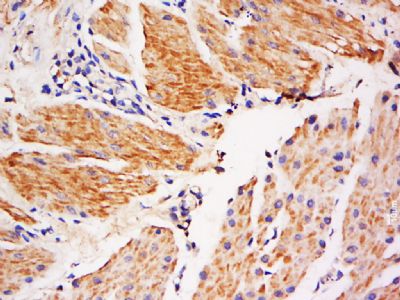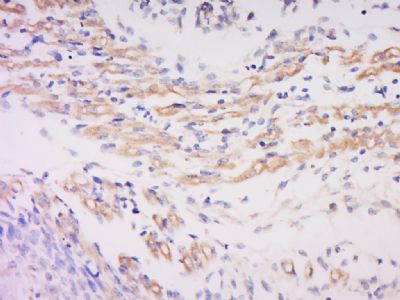产品中心
当前位置:首页>产品中心Anti-GJA8
货号: bs-13364R 基本售价: 1380.0 元 规格: 100ul
- 规格:100ul
- 价格:1380.00元
- 规格:200ul
- 价格:2200.00元
产品信息
- 产品编号
- bs-13364R
- 英文名称
- GJA8
- 中文名称
- 间隙连结蛋白50/白内障相关蛋白抗体
- 别 名
- CAE; CAE1; cataract, zonular pulverulent 1 (FY-linked); Connexin 50; Connexin50; Connexin-50; Cx50; CXA8_HUMAN; Gap junction alpha 8 protein; Gap junction alpha-8 protein; Gap junction membrane channel protein alpha 8 (connexin 50); gap junction protein, alpha 8, 50kD; Gja8; Lens fiber protein MP70.
- 规格价格
- 100ul/1380元购买 200ul/2200元购买 大包装/询价
- 说 明 书
- 100ul 200ul
- 研究领域
- 细胞生物 神经生物学 信号转导
- 抗体来源
- Rabbit
- 克隆类型
- Polyclonal
- 交叉反应
- Human, Mouse, Rat, Chicken, Dog, Cow, Rabbit, Sheep,
- 产品应用
- ELISA=1:500-1000 IHC-P=1:400-800 IHC-F=1:400-800 ICC=1:100-500 IF=1:100-500 (石蜡切片需做抗原修复)
not yet tested in other applications.
optimal dilutions/concentrations should be determined by the end user.
- 分 子 量
- 48kDa
- 细胞定位
- 细胞膜
- 性 状
- Lyophilized or Liquid
- 浓 度
- 1mg/ml
- 免 疫 原
- KLH conjugated synthetic peptide derived from human GJA8/Connexin 50:151-250/433 <Extracellular>
- 亚 型
- IgG
- 纯化方法
- affinity purified by Protein A
- 储 存 液
- 0.01M TBS(pH7.4) with 1% BSA, 0.03% Proclin300 and 50% Glycerol.
- 保存条件
- Store at -20 °C for one year. Avoid repeated freeze/thaw cycles. The lyophilized antibody is stable at room temperature for at least one month and for greater than a year when kept at -20°C. When reconstituted in sterile pH 7.4 0.01M PBS or diluent of antibody the antibody is stable for at least two weeks at 2-4 °C.
- PubMed
- PubMed
- 产品介绍
- background:
The connexin family of proteins form hexameric complexes called “connexons” that facilitate movement of low molecular weight proteins between cells via gap junctions (1). Connexin proteins share a common topology of 4 transmembrane alpha-helical domains, two extracellular loops, a cytoplasmic loop, and cytoplasmic N- and C-termini (2). Many of the key functional differences arise from specific amino-acid substitutions in the most highly conserved domains, the transmembrane and extracellular regions (2). Each of the approximately 20 connexin isoforms produces channels with distinct permeabilities and electrical and chemical sensitivities; therefore, one connexin usually cannot fully substitute for another (2). Consequently, a wide variety of malignant phenotypes associate with decreased connexin expression and gap junction communication, dependent on the particular connexin that is effected (3, 2). For instance, deletion of the gene encoding connexin 50, normally expressed in the lens, produces cataracts, though not as severe as with deletion of connexin 46 (4).
Function:
One gap junction consists of a cluster of closely packed pairs of transmembrane channels, the connexons, through which materials of low MW diffuse from one cell to a neighboring cell.
Subunit:
A connexon is composed of a hexamer of connexins. This particular connexin only forms junctional channels.
Subcellular Location:
Cell membrane. Cell junction; gap junction.
Tissue Specificity:
Eye lens.
DISEASE:
Defects in GJA8 are the cause of cataract zonular pulverulent type 1 (CZP1) [MIM:116200]. A form of zonular cataract. Zonular or lamellar cataracts are opacities, broad or narrow, usually consisting of powdery white dots affecting only certain layers or zones between the cortex and nucleus of an otherwise clear lens. The opacity may be so dense as to render the entire central region of the lens completely opaque, or so translucent that vision is hardly if at all impeded. Zonular cataracts generally do not involve the embryonic nucleus, though sometimes they involve the fetal nucleus. Usually sharply separated from a clear cortex outside them, they may have projections from their outer edges known as riders or spokes.
Defects in GJA8 are the cause of cataract-microcornea syndrome (CAMIS) [MIM:116150]. Cataract-microcornea syndrome is characterized by the association of congenital cataract and microcornea without any other systemic anomaly or dysmorphism. Clinical findings include a corneal diameter inferior to 10 mm in both meridians in an otherwise normal eye, and an inherited cataract, which is most often bilateral posterior polar with opacification in the lens periphery. The cataract progresses to form a total cataract after visual maturity has been achieved, requiring cataract extraction in the first to third decade of life. Microcornea-cataract syndrome can be associated with other rare ocular manifestations, including myopia, iris coloboma, sclerocornea and Peters anomaly. Transmission is in most cases autosomal dominant, but cases of autosomal recessive transmission have recently been described.
Similarity:
Belongs to the connexin family. Alpha-type (group II) subfamily.
SWISS:
P48165
Gene ID:
2703
Database links:Entrez Gene: 2703 Human
Entrez Gene: 14616 Mouse
Omim: 600897 Human
SwissProt: P48165 Human
SwissProt: P28236 Mouse
SwissProt: Q8K4Q9 Rat
Unigene: 632441 Human
Unigene: 461093 Mouse
Unigene: 468160 Mouse
Unigene: 86658 Rat
Important Note:
This product as supplied is intended for research use only, not for use in human, therapeutic or diagnostic applications.
- 产品图片
 Tissue/cell: Mouse placenta tissue; 4% Paraformaldehyde-fixed and paraffin-embedded;
Tissue/cell: Mouse placenta tissue; 4% Paraformaldehyde-fixed and paraffin-embedded;
Antigen retrieval: citrate buffer ( 0.01M, pH 6.0 ), Boiling bathing for 15min; Block endogenous peroxidase by 3% Hydrogen peroxide for 30min; Blocking buffer (normal goat serum,C-0005) at 37℃ for 20 min;
Incubation: Anti-GJA8 Polyclonal Antibody, Unconjugated(bs-13364R) 1:500, overnight at 4°C, followed by conjugation to the secondary antibody(SP-0023) and DAB(C-0010) staining Tissue/cell: Mouse embryo tissue; 4% Paraformaldehyde-fixed and paraffin-embedded;
Tissue/cell: Mouse embryo tissue; 4% Paraformaldehyde-fixed and paraffin-embedded;
Antigen retrieval: citrate buffer ( 0.01M, pH 6.0 ), Boiling bathing for 15min; Block endogenous peroxidase by 3% Hydrogen peroxide for 30min; Blocking buffer (normal goat serum,C-0005) at 37℃ for 20 min;
Incubation: Anti-GJA8 Polyclonal Antibody, Unconjugated(bs-13364R) 1:500, overnight at 4°C, followed by conjugation to the secondary antibody(SP-0023) and DAB(C-0010) staining

